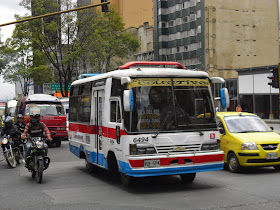It’s now almost two years since Bogotá’s Sitp (Sistema Integrado de Transporte Público, Integrated Public Transport System) buses started rolling out.
Unlike Santiago de Chile, authorities here went for a gradual process of replacing the old private, cash-in-hand system of busetas/colectivos with the new ‘streamlined’, public-private, card-based model.
However, we’re fast approaching Sitp domination time. Well, according to those calling the shots we are.
 |
| Come on people, don't be shy; jump right on. (Photo from Facebook.) |
Speaking on the introduction of an exclusive Sitp bus corridor on one of the capital’s main thoroughfares, Carrera Septima (7th Avenue), the city’s mobility secretary María Constanza García said that by the first week of September they hoped to have “retired 100 per cent the routes of the old buses that are on the corridor.”
Experience lets us know that such an aspiration might be a just a tad ambitious; especially judging by the first few days of the new ‘exclusive’ lane way. It’s difficult to see the old, fume-spluttering buses meekly retire in the coming weeks when demand for them seems as high as ever.
Despite all the efforts to wean people off their previous way of commuting, it’s still a common sight to see – a few routes aside – a near-empty blue Sitp bus crawling alongside an old school one with people hanging out the doors.
This lack of enthusiasm among the city’s inhabitants to change their ways is not surprising when you consider the current state of play.
Experience lets us know that such an aspiration might be a just a tad ambitious; especially judging by the first few days of the new ‘exclusive’ lane way. It’s difficult to see the old, fume-spluttering buses meekly retire in the coming weeks when demand for them seems as high as ever.
Despite all the efforts to wean people off their previous way of commuting, it’s still a common sight to see – a few routes aside – a near-empty blue Sitp bus crawling alongside an old school one with people hanging out the doors.
This lack of enthusiasm among the city’s inhabitants to change their ways is not surprising when you consider the current state of play.
Firstly, the lack of easy-to-find route information is a major hindrance. OK, there is an app, Moovit, which serves somewhat as an on-line route finder. Yet it nearly tries to be too clever, telling people where to walk, for what distance and what shops you can find along the way (yes, I made that last one up; could be an idea, though). Most people just want to know which bus goes where. On that, it scores badly.
Some physical maps at the actual bus shelters and a little more detailed information on the stops for each route would come in handy, rather than some irrelevant bus number with just the final destination.
Regardless of that, there doesn’t seem to be a ready-made replacement for the Calle 19 (19th Street)/Carrera Tercera (3rd Avenue), Septima north-bound route; a popular, busy run that has been generally well served under the old operators.
What’s more, the private system – in typical Colombian contradictory fashion – still seems more user-friendly, even if this ‘user-friendliness’ is often a major inconvenience not only for other road users but fellow passengers also.
Some physical maps at the actual bus shelters and a little more detailed information on the stops for each route would come in handy, rather than some irrelevant bus number with just the final destination.
Regardless of that, there doesn’t seem to be a ready-made replacement for the Calle 19 (19th Street)/Carrera Tercera (3rd Avenue), Septima north-bound route; a popular, busy run that has been generally well served under the old operators.
What’s more, the private system – in typical Colombian contradictory fashion – still seems more user-friendly, even if this ‘user-friendliness’ is often a major inconvenience not only for other road users but fellow passengers also.
Indeed, what you might think is good one day about the old buses’ way of doing things can be a source of frustration the next.
For example, that you can flag down or get off one of them from any location is great. However, if you’re on a bus in a rush to get somewhere and it’s stopping every second to pick up and drop off people, breaking like a rally car, it’s damn right annoying.
Then you have what is probably one of the busetas/colectivos biggest pull factors: The fact that you can get on even if you don’t have the full fare.
 |
| Old school: They haven't gone away, you know. |
Then you have what is probably one of the busetas/colectivos biggest pull factors: The fact that you can get on even if you don’t have the full fare.
Just wave a 1,000 peso note at the driver to signal your lack of funds and more often than not he (for it’s rarely a she) will let you on.
On the downside, in contrast to the more regulated, ‘cold’, Sitp, the old system is still awash with the not very washed, usually unwelcome, bus vendors and wannabe rap artists.
So while Bogotá’s bus future may be Sitp blue, there’s still a bit of life in the old operators yet.
So while Bogotá’s bus future may be Sitp blue, there’s still a bit of life in the old operators yet.
Let’s see how things unfold over the next two years. Sure what’s the rush guys?
No comments:
Post a Comment